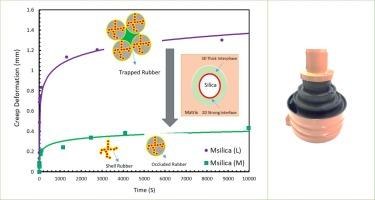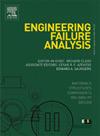利用二氧化硅表面工程控制天然橡胶基复合材料的抗蠕变失效性能,使其在机车车辆悬挂系统中得到潜在应用
IF 4.4
2区 工程技术
Q1 ENGINEERING, MECHANICAL
引用次数: 0
摘要
二氧化硅对聚合物链的固定作用一方面可以增加粘弹性能量损失,另一方面可以推迟链的松弛并暂时掩盖蠕变变形。目前还不清楚相间层的形成如何导致抗蠕变性的变化。双官能硅烷 "双(三乙氧基硅丙基)二硫化物 "可在橡胶-二氧化硅界面上诱导不同程度的共价键,并带来多种固定程度。有趣的是,研究发现,通过控制界面现象,可以在 4.35-1.65 (%/decade) 的大范围内改变蠕变速率。研究从机理上解释了中等表面处理程度的样品如何具有最大的抗蠕变性。填料网络的形成表明,在聚合物与填料之间没有良好相互作用的体系中,填料网络在增加高温蠕变失效方面起着至关重要的作用。本文章由计算机程序翻译,如有差异,请以英文原文为准。

Surface engineering of silica to control creep failure resistance of natural rubber-based composites for potential application in the suspension of rolling stock
Immobilization of polymer chains by silica on one side could increase the viscoelastic energy loss and on the other could postpone chain relaxations and temporarily conceal creep deformation. It is not yet clear how the formation of an interphase layer contributes to the change of creep resistance. Bifunctional silane, “Bis(triethoxysilylpropyl) disulfide” is employed to induce various degrees of covalent bonds at the rubber-silica interface, and also brings multiple degrees of immobilization. Interestingly, it was found that by controlling interfacial phenomena, the creep rate can be altered in a wide range of 4.35–1.65 (%/decade). It was mechanistically explained how the maximum creep resistance is observed for the sample having a medium level of surface treatment. The formation of a filler network indicated an essential role in increasing the high-temperature creep failure of systems having no favorable polymer-filler interaction.
求助全文
通过发布文献求助,成功后即可免费获取论文全文。
去求助
来源期刊

Engineering Failure Analysis
工程技术-材料科学:表征与测试
CiteScore
7.70
自引率
20.00%
发文量
956
审稿时长
47 days
期刊介绍:
Engineering Failure Analysis publishes research papers describing the analysis of engineering failures and related studies.
Papers relating to the structure, properties and behaviour of engineering materials are encouraged, particularly those which also involve the detailed application of materials parameters to problems in engineering structures, components and design. In addition to the area of materials engineering, the interacting fields of mechanical, manufacturing, aeronautical, civil, chemical, corrosion and design engineering are considered relevant. Activity should be directed at analysing engineering failures and carrying out research to help reduce the incidences of failures and to extend the operating horizons of engineering materials.
Emphasis is placed on the mechanical properties of materials and their behaviour when influenced by structure, process and environment. Metallic, polymeric, ceramic and natural materials are all included and the application of these materials to real engineering situations should be emphasised. The use of a case-study based approach is also encouraged.
Engineering Failure Analysis provides essential reference material and critical feedback into the design process thereby contributing to the prevention of engineering failures in the future. All submissions will be subject to peer review from leading experts in the field.
 求助内容:
求助内容: 应助结果提醒方式:
应助结果提醒方式:


